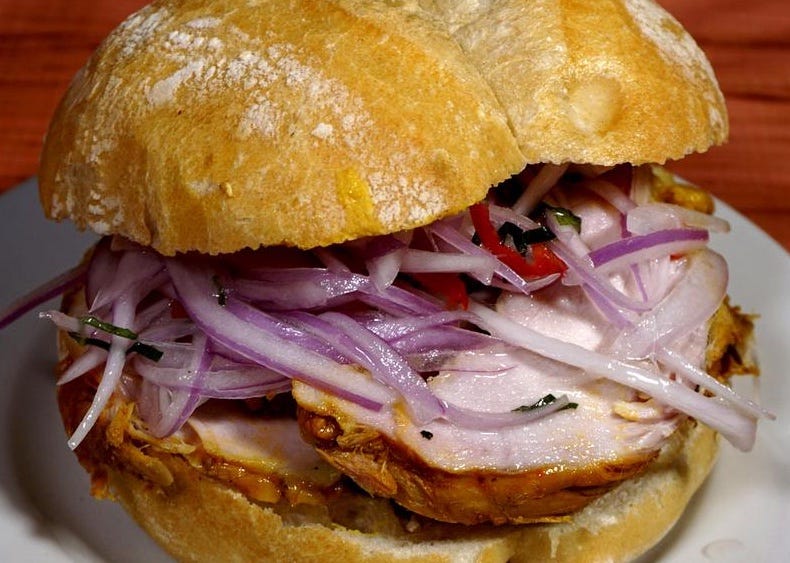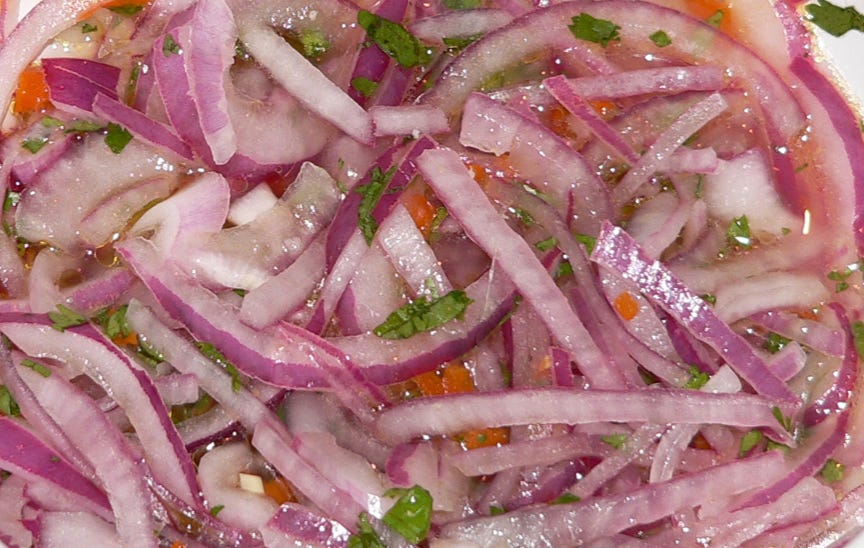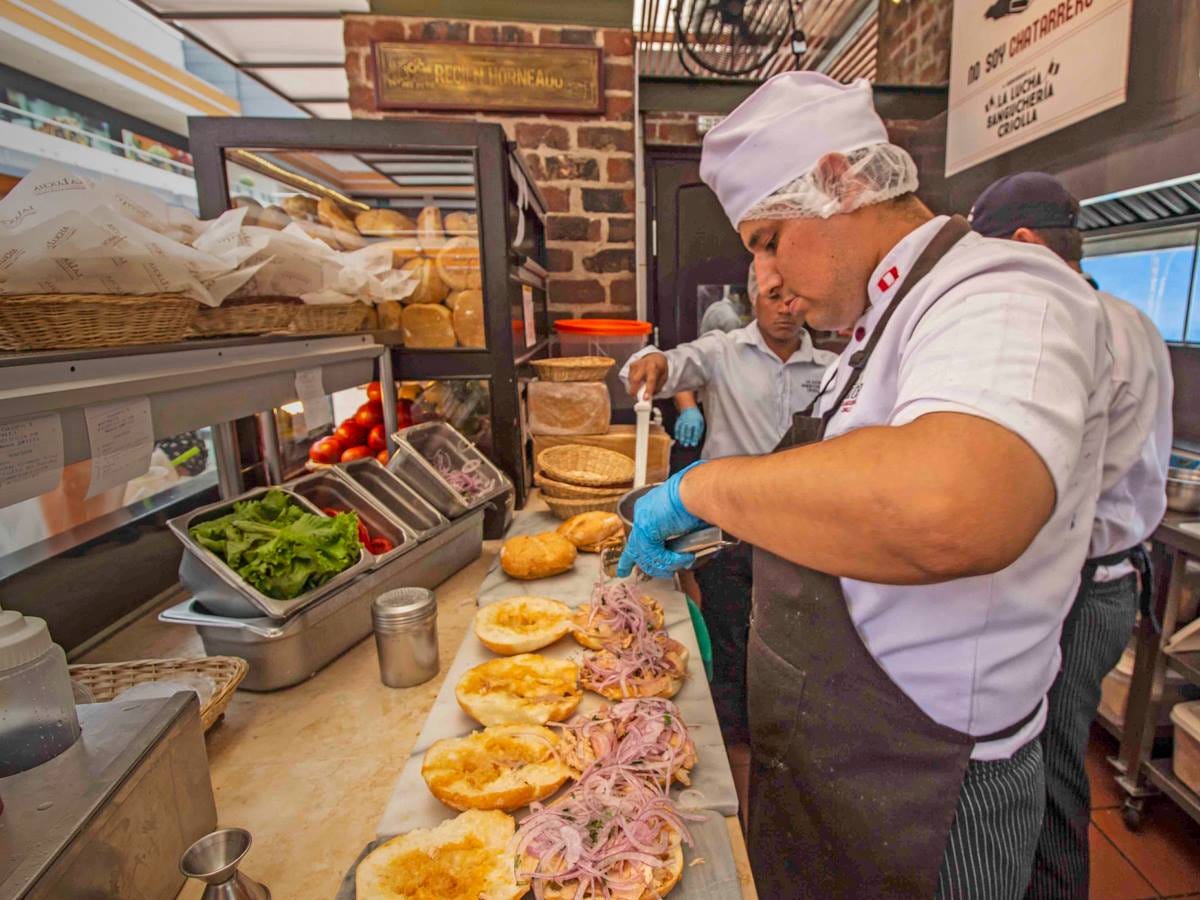Notable Sandwiches #21: The Butifarra
A delectable Peruvian staple, to be eaten with relish
Welcome to the latest installment of Notable Sandwiches, the feature where I, alongside my editor David Swanson, stumble through the demented and mysterious document that is Wikipedia’s List of Notable Sandwiches. This week, greatly buoyed by your recent praise of the sandwich project, I tackle a Peruvian staple: the butifarra.
It’s April Fool’s Day today and my personal life went to hell this week in some pretty spectacular ways, leading me to forget, until 3am Thursday, that I had a sandwich column due. But anyone with profound anxiety knows that sometimes, in crisis, it can alchemize into clarity. And so on this April Fool’s Day, feeling quite like the greatest fool of this or any month, I turn to face the Peruvian butifarra sandwich with uncharacteristic alacrity…
And relish. Did I mention there’s a relish on this sandwich? The actual dish is a fairly prosaic if much-beloved staple of sangucherias and street vendors slinging simple fare on the streets of Lima or Cuzco: seasoned country ham (jamon del pais), mayonnaise, country or French bread. (As always, for a more exhaustive recipe-testing treatment of this sandwich, you can turn to the good folks at Sandwich Tribunal, who cured, brined and sliced their very own jamon del pais with a patience and skill I shall frankly never possess). The sandwich takes its name, somewhat counterintuitively, from botifarra, which is both a Spanish sausage and a crude Catalan gesture not unlike our raised middle finger. But to me the genius of the butifarra is the salsa criolla—a gem-bright pile of red onions and yellow chilis doused with lime and piled atop the pork, rendering what might otherwise be a tame and monochromatic dining experience crunchy and acidic and altogether elevated.
The term salsa criolla is sometimes translated as “Creole sauce”—a rough, serviceable translation, which, as many translations do, misses essential cultural context. (Vladimir Nabokov, in his rather tedious translation of Pushkin’s Eugene Onegin, once said his ideal translation would involve “footnotes reaching up like skyscrapers to the top of this or that page so as to leave only the gleam of one textual line between commentary and eternity”—which is, frankly, not ideal for a poem, and still less for a recipe.)
The word “creole” in English is stolen from the French, who stole the word from the Portuguese criuolo—meaning “a person raised in one’s house.” It can refer to ethnic groups arising from colonization and subsequent racial mixing, or linguistic admixtures that have both colonial and indigenous characteristics, such as Haitian “Kreyol”, “Krio” in Sierra Leone, or the Alaskan “Kriol” that arose from the mixing of Russian fur traders with Alaska Natives. (In the mainland U.S., the word “Creole” is most often used in reference to the cuisine and ethnicities of French Louisiana.) In the Latin American context, however, criollo traditionally refers to descendants of Spanish colonists and criollismo the culture and cuisine arising from them—a means to distinguish “pure” colonists of Spanish descent from indigenous people or mixed-race mestizos, a term derived from racial stratification.
In Peru, however, the notion is turned on its head: criollos and criollismo have long referred to the uniquely Peruvian blend of indigenous Peruvian, African, Spanish and mestizo cultures, particularly along the Pacific coast. According to the Harvard anthropologist Ozzie G. Simmons (whose fieldwork in Peru dates from the 1950s and reads like it), criollismo is “the mestizo’s answer to the painful question of who and what he is, his assertion that his ‘way of life’ is a positive creation of his own rather than a casual European-indigenous mixture… a strictly local development, a Peruvian development.” October 31st in Peru is día de la canción criolla—the Day of Criollo Music—where you might take in, for example, the graceful coastal couple’s dance that is the Marinera:
Which brings us back to the salsa criolla: while dishes of the same name are served across Latin America, the Peruvian version differs entirely from that of, say, Argentina, where it is a rather unremarkable condiment of tomato, red bell pepper, garlic and onion. Peruvian salsa criolla has the flair of Peruvian criollismo: to quote Simmons again, criollo foods are “dishes, usually seasoned generously with hot peppers, that are prepared in a manner different from foreign or other Peruvian dishes.” The salsa criolla of Peru is a spiky tangle of finely-sliced red onions (cut “feather-style,” and razor-thin), hot jewel-toned aji amarillo peppers, lime and cilantro. It’s used as a condiment and as a side dish in and of itself, an adornment rich in acid, and color, and spice.
The history of the onion, as it happens, is completely fascinating—it’s quite difficult to parse the geographic origin of its cultivation, which seems to have developed simultaneously in Central Asia, Iran, Pakistan and elsewhere. The wild onion, now extinct, grew all over the world, and was cultivated as far back as 5,000 years ago; the Ancient Egyptians purportedly revered the onion as a symbol of eternal life, and placed onions in the eye sockets of dead pharaohs. Early settlers in the Americas brought onions in their boats, only to find Native Americans had already been cultivating the crop for ages. It’s difficult to determine, specifically, whether or not onions arrived in Peru as a product of colonization, although the London Encyclopedia of 1829 claims that onions had always been cultivated throughout South America, unlike cabbages and turnips, which were brought by colonists. Also, for whatever it’s worth, the government of the south Peruvian region of Tacna has an Onion Project that recommends placing onions all around your house as a means of preventing flu.
At any rate, consuming raw red onion in great quantity can be a daunting prospect, particularly for those who want to steal a kiss after a hearty meal. But the salsa criolla offers an amelioration of the alliaceous bite. The red onions should be sweated before serving: while this usually means cooking, you can also defang their sharpness by soaking them in very cold water, or salting them, or splitting the difference and soaking them in salted ice water. This process sweetens the purple-skinned strips, readies them to absorb the lime and the floral spice of the aji amarillo, renders them palatable, and allows the flavors to mix and marry in their own one-bowl criollismo of the palate.
The Sword and the Sandwich is a newsletter about deadly serious extremism and equally serious sandwiches. Please consider supporting this work with a paid subscription:
It can be true that colonial influence—which is always a product of violent conquest, of taking more than it gives, sending away the best of the earth and its resources—involves a dulling of what existed before, a stamping out of what was in order to create a new order in its mold. It can also be true that subsequent generations may reclaim, remix, creolize, and reinvent themselves, and their food, and their song, taking what was damaged and recreating it. Whether the onion was brought to Peru or existed there since time immemorial, it has been cultivated, for centuries, by inhabitants of a world irrevocably changed by men in ships and the world and wounds they made.
It’s April, the month of rain and rebirth; time to watch the wet brown earth give rise to new green life, to pile bright things high, drown out the monochrome. So the sweated onion gets paired with the indigenous hot pepper, and over the sea and years the Austrian waltz becomes the vals criollo—its own dance, a new rhythm, a concatenation constantly being born beside the blue Pacific, the steps drumming out a rhythm of what was taken and what is taken back.









I wish everyone would sweat their red onions before putting them all over otherwise palatable food.